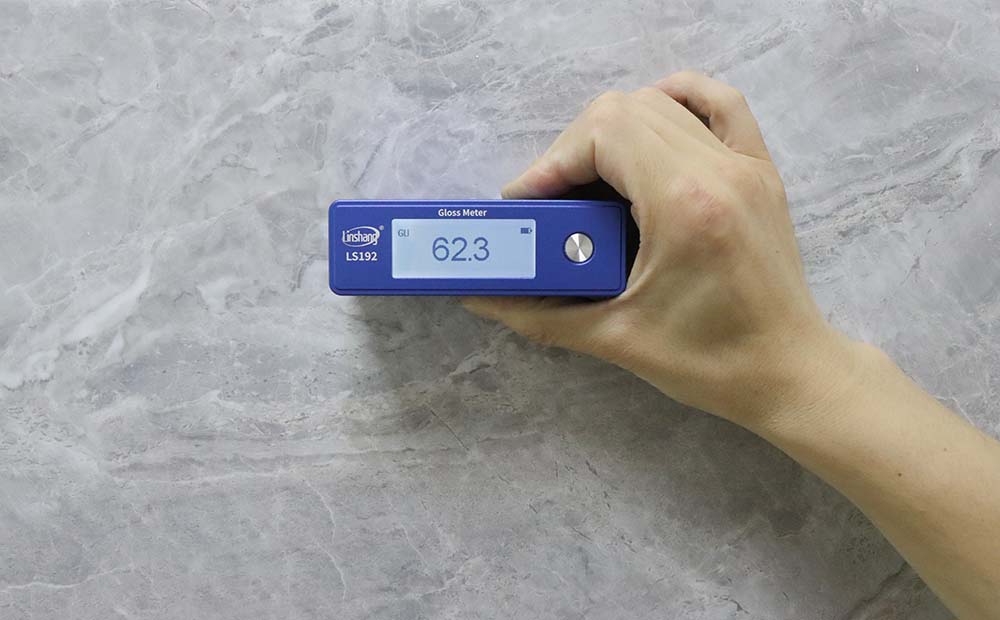Marble Gloss Meter | How Do We Measure Stone Gloss?
Stone is widely used in our lives, especially in the decoration industry. Do you know marble, granite, etc.? In fact, stone gloss is an important factor in judging the quality of decoration materials. Because different decoration effects have different requirements for the gloss of the stone.
1. The classification of the stone gloss
Due to the different hardness, structure, mineral content and mineral particle size, the stone gloss is different. Generally, the stone gloss is divided into three levels: "high gloss (gloss ≥80GU)" and "general gloss" ( Gloss between 70-80GU), "low gloss" (gloss below 70GU).
Granite marble is generally polished, but the gloss of polished marble is about 80GU and the gloss of granite can reach more than 90GU. To maintain its gloss for a long period of time, professional maintenance is required. The gloss of the marble surface after crystal curing is generally 85GU-100GU which is in normal range. The matte surface is a low degree of gloss of 10-40GU, which produces diffuse reflection. The difference between a glossy surface and a matte surface is whether it can reflect people like a mirror. The glossy surface is finely polished on the basis of a matte surface.
In ordinary stone decoration, the gloss above 75GU can meet the general decoration requirements. In some more advanced places, decorative materials need to be tested with marble gloss meter according to customer requirements.
2. Factors affecting the gloss of stone
The gloss of stone is mainly divided into three types: actual polished gloss, polishable gloss and theoretical gloss. There is a certain relationship between these three. In general, the theoretical gloss is greater than the polishable gloss of the stone. And the polishable gloss of the stone is greater than the actual polishing gloss of the stone.
(1) The constituent particles of stone
The mineral composition of the stone will affect the gloss of the stone, which mainly refers to the size of the crystal particles that make up the stone. The larger the size of the crystal particles, the worse the gloss and the polishability of the stone. Conversely, the smaller the crystal particles, the gloss is more uniform. Then the better the stone can be polished. The different measurement directions of the polished surface of stone are also different. So the gloss is directional. Small particles of stone polished surface have better consistency in different directions.
(2) Stone hardness
The gloss of the stone is also related to the hardness of the stone. The higher the hardness, the better the gloss of the stone under the same conditions. Because the higher the hardness of the stone, the slower the recrystallization and grinding of the stone. In actual operation, the slower the swing speed of the machine we master.
(3) Density of stone
The density of the stone will affect the water absorption of the stone. The larger the density, the smaller the water absorption. The smaller the density, the larger the water absorption. Stones with large water absorption are not conducive to the formation of a polishing layer. The density of the stone will directly affect the polishability of the stone. The greater the density of the stone, the better the crystal hardening effect. Otherwise, the worse the effect of crystal hardening, the worse the polishability of the material.
(4) Artificial processing factors
It is believed that factors mainly refer to processing skills and processing techniques and the same materials are given to different people. The finished product's quality gloss index is also different. The same material is meticulously processed, the delicate gloss value is higher and the rough gloss value is lower.
3. How to detect the gloss of stone
When measuring the gloss of stone, the human eye can only roughly judge the gloss of the stone, but it is impossible to determine exactly what the gloss of the stone is. At this time, we need to use the marble gloss meter to judge the gloss value of the stone. To measure the gloss of stone with a marble gloss meter, it is recommended to use Linshang marble gloss meter.
Linshang Technology has produced two marble gloss meters, namely LS191 and LS192 gloss meters. The measurement range of LS191 is 0-200GU and the range of LS192 is 0-1000GU. The measuring angles of these two marble gloss meters are both 60 degrees. The measuring range is very wide. It can measure paint, paper, ceramics, mirrors, etc. The instrument can measure the maximum value, minimum value, average value, real-time value, measurement times and standard deviation. It is very convenient to use and you can also judge the uniformity of the gloss through the standard deviation value.
